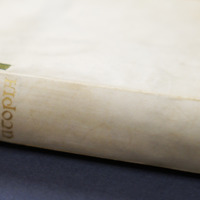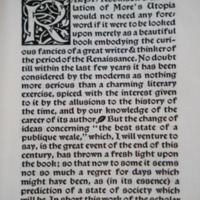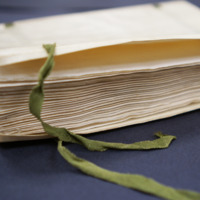Utopia
Dublin Core
Title
Utopia
Description
English
William Morris (1834-1896), product of an upper-middle class upbringing of the 19th century, was actually a socialist with a great reverence for the skilled craftsman whose output was a product of labour done by hand, rather than that of mass-produced mechanization. Disgruntled with the uniform and shoddy artistic production of the Age of Industrialization of the London of his time, Morris looked back to the artists of the past for inspiration. A true Renaissance man if ever there was one, Morris was involved in almost every branch of the Arts : textiles, metal work, furniture making, architecture, stained glass, decorative arts, painting, literature, and indeed, book production. As with his other endeavours within the Arts, Morris turned to the pre-mechanized age for inspiration with book printing: the era of the hand-press. Morris founded the Kelmscott Press in 1891. All aspects of Kelmscott Press books were produced by hand : the paper, the binding, the pressing of an edition, and the fonts. Morris designed the fonts used at his Press himself, with Chaucer (designed for his magnum opus “The Kelmscott Chaucer”, Golden (designed for his printing of Voraigne’s Golden Legend) and Troy being his most famous.
Français
Issu des classes sué́rieures et instruites de Londres, William Morris (1834-1896) était un socialiste, grand amateur du travail manuel ré́alisé avec patience par les artisans, en réaction à l’industrialisation de la société londonienne de la seconde moitié du XIXe sècle. En véritable humaniste de la Renaissance, il s’est intéressé à̀ tous les arts : textile, métallurgie, fabrication de meubles, architecture, verrerie, arts décoratifs, peinture, littérature et bien sûr à la production des livres. Morris a fondé la Kelmscott Press en 1891 avec laquelle il allait produire des livres entièrement fabriqués à la main : le papier, l’impression, les caractères d’imprimerie, la reliure, etc. Il a d’ailleurs créé lui-même plusieurs polices de caractères dont les plus célèbres sont la police Chaucer créée spécialement pour l’édition des œuvres de Chaucer et le Golden, pour son édition de la Légende dorée de Voraigne.
William Morris (1834-1896), product of an upper-middle class upbringing of the 19th century, was actually a socialist with a great reverence for the skilled craftsman whose output was a product of labour done by hand, rather than that of mass-produced mechanization. Disgruntled with the uniform and shoddy artistic production of the Age of Industrialization of the London of his time, Morris looked back to the artists of the past for inspiration. A true Renaissance man if ever there was one, Morris was involved in almost every branch of the Arts : textiles, metal work, furniture making, architecture, stained glass, decorative arts, painting, literature, and indeed, book production. As with his other endeavours within the Arts, Morris turned to the pre-mechanized age for inspiration with book printing: the era of the hand-press. Morris founded the Kelmscott Press in 1891. All aspects of Kelmscott Press books were produced by hand : the paper, the binding, the pressing of an edition, and the fonts. Morris designed the fonts used at his Press himself, with Chaucer (designed for his magnum opus “The Kelmscott Chaucer”, Golden (designed for his printing of Voraigne’s Golden Legend) and Troy being his most famous.
Français
Issu des classes sué́rieures et instruites de Londres, William Morris (1834-1896) était un socialiste, grand amateur du travail manuel ré́alisé avec patience par les artisans, en réaction à l’industrialisation de la société londonienne de la seconde moitié du XIXe sècle. En véritable humaniste de la Renaissance, il s’est intéressé à̀ tous les arts : textile, métallurgie, fabrication de meubles, architecture, verrerie, arts décoratifs, peinture, littérature et bien sûr à la production des livres. Morris a fondé la Kelmscott Press en 1891 avec laquelle il allait produire des livres entièrement fabriqués à la main : le papier, l’impression, les caractères d’imprimerie, la reliure, etc. Il a d’ailleurs créé lui-même plusieurs polices de caractères dont les plus célèbres sont la police Chaucer créée spécialement pour l’édition des œuvres de Chaucer et le Golden, pour son édition de la Légende dorée de Voraigne.
Creator
More, Thomas, Saint (1478-1535)
Source
Archives and Special Collections, University of Ottawa [HX811 1516. E893 1893] /Archives et collections spéciales, Université d'Ottawa [HX811 1516. E893 1893]
Publisher
Hammersmith, William Morris at the Kelmscott Press
Date
1893
Rights
Archives and Special Collections, University of Ottawa /Archives et collections spéciales, Université d'Ottawa
Format
Book/Livre
Language
English/Anglais
Type
Text/Texte
Identifier
ARSC_PR_HX811 1516. E893 1893
Collection
Citation
More, Thomas, Saint (1478-1535), “Utopia,” Archives et collections spéciales, Bibliothèque d'Ottawa, accessed December 13, 2025, http://omeka.uottawa.ca/arcs/items/show/102.




